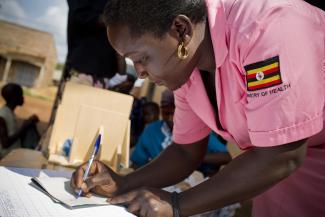In 2016, the Ugandan Ministry of Health (MoH) was unable to fully spend the available budget for healthcare. These funds could have been used to save lives or deliver care, but instead were simply returned back to the Treasury.
To address these lost opportunities for the health sector, USAID began collaborating with the Ugandan MoH to improve their budget execution. Analyses based on local program data enabled the government to better identify budget execution bottlenecks and come up with solutions to overcome them. In addition, USAID supported the rollout of Program Based Budgeting, which links budget allocation to program outcomes and results as opposed to traditional input-based budgeting. The MoH and districts now have more flexibility to program resources as needed to meet national health goals and service delivery priorities, rather than being restricted to budgets based on inputs such as fuel and paper that may not align with programming priorities. The MoH and districts are able to take advantage of this flexibility by using procurement tracking tools and processes such as frequent reviews of budget performance which allow them to make adjustments based on real-time information.
With USAID’s budget planning and technical assistance support, the MoH has improved its budget execution rate from 79 to 97 percent, freeing up $17 million in domestic health funding for programs that will directly benefit Ugandans. The quality of MOH’s spending has also improved significantly as a result of rolling out Program Based Budgeting.
By supporting domestic resource mobilization efforts, including maximizing the use of the domestic health budget, USAID is partnering with countries like Uganda on their Journey to Self-Reliance.

Photo Credit: Kate Holt/MCSP
